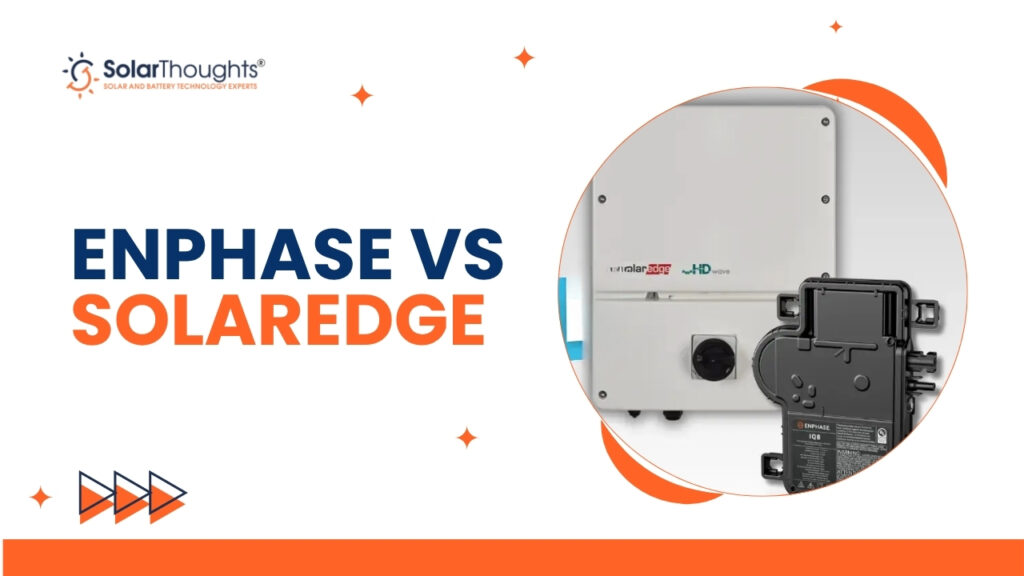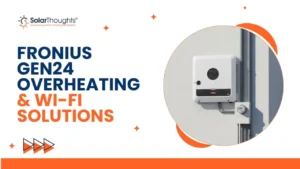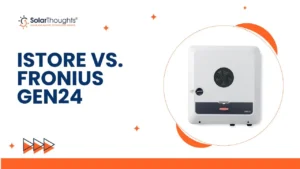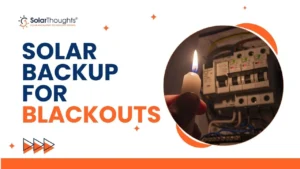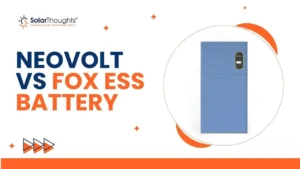The Enphase vs SolarEdge decision could save or cost you thousands. These two giants power over 90% of US solar installations, but which one actually delivers better returns on Australian rooftops? Get this wrong, and you’ll pay for it—literally.
Table of Contents
ToggleYour roof tells the story. Complex layouts with shading favor Enphase microinverters that optimize each panel independently. Simple, unshaded roofs? SolarEdge offers better value. But here’s the game-changer: Enphase lasts 25+ years while string inverters need costly replacement after 5-12 years. That $2,000-$3,000 replacement eats straight into your solar savings.
When comparing Enphase vs SolarEdge in 2025, the math is clear: a 10kW system cuts bills by $4,000 yearly, making Enphase’s premium worthwhile through eliminated replacement costs alone. Let’s break down which system fits your home, roof, and budget.
Inverter Technology: Microinverter vs Optimizer Explained
The core distinction between Enphase and SolarEdge comes down to where the magic happens—specifically, where your solar panels’ DC electricity becomes the AC power your home actually uses.
How Enphase microinverters convert DC to AC at the panel level
Enphase attaches small microinverters directly to each solar panel on your roof. These compact units handle multiple tasks at once. They continuously monitor each panel’s output, adjusting voltage and current through Maximum Power Point Tracking (MPPT) several times per second to capture peak performance.
Most importantly, they convert DC electricity into usable AC power right there at the panel level. This conversion happens independently for every panel, so if one panel struggles with shade or debris, the others keep performing at full capacity. Enphase microinverters typically achieve 96% to 97% efficiency in this conversion process. The AC power then flows through standard electrical wiring straight to your home’s main panel.
How SolarEdge optimizers work with a central inverter
SolarEdge takes a different path with power optimizer technology. These optimizers also attach to individual panels and perform MPPT tracking at each module. The key difference? They don’t convert DC to AC at the panel. Instead, they condition and optimize the DC power before sending it down to a central inverter, usually wall-mounted near your electrical panel.
This central unit handles all the DC-to-AC conversion for your entire system. The SolarEdge Home Hub inverter achieves over 99% efficiency in this process. This setup offers a distinct advantage for battery storage—DC power can charge batteries directly without extra conversion steps.
Impact on system design and wiring
These architectural differences create real-world implications for installation and future expansion. Enphase systems use standard AC wiring from the roof, similar to regular household electrical connections. This approach often simplifies installation and reduces safety concerns. SolarEdge systems require DC wiring in a metal conduit until reaching the central inverter.
When it comes to expanding your system later, Enphase offers more flexibility since you can add panels with microinverters without worrying about hitting the central inverter capacity limits. Enphase systems also handle complex roof designs more gracefully—multiple orientations and angles work seamlessly since each panel operates independently. For Australian homes dealing with diverse roofing challenges and extreme heat conditions, these design differences matter when evaluating long-term reliability and performance.
Performance and Efficiency in Australian Conditions
Australia’s climate demands more from solar systems than most other countries. Intense sunlight, unpredictable weather patterns, and extreme temperatures put these two technologies to the test in ways that matter for your energy harvest.
Shading Tolerance: Independent vs Centralized Conversion
Here’s where the design philosophies create real-world differences. Enphase microinverters convert power at each panel, so every module works independently—if one panel gets shaded, dirty, or develops a fault, only that specific panel’s output drops. SolarEdge optimizers track each panel’s maximum power point independently, but they still rely on the central inverter for final conversion. On Brisbane roofs with complex layouts or partial shading issues, this distinction can make or break your system’s performance.
Energy Harvest: MPPT at Panel vs System Level
Both systems optimize power differently, and the numbers tell an interesting story. Enphase performs MPPT tracking at each individual panel, plus their microinverters use Burst Mode technology to squeeze more energy from low-light conditions. SolarEdge counters with higher efficiency—their power optimizers achieve 99.5% efficiency compared to Enphase’s 97%. SolarEdge also starts producing power at just 12.5V DC versus Enphase’s 22-33V DC requirement, potentially capturing more energy during dawn and dusk hours.
Heat Resistance: Roof-mounted microinverters vs Wall-mounted inverters
Australian summers test equipment limits. Rooftops regularly hit 65-75°C during peak heat. Enphase microinverters handle ambient temperatures up to 65°C, while SolarEdge optimizers are rated for up to 85°C. Real-world testing during Australia’s hottest days shows the challenge: Penrith hit 48.9°C ambient with microinverter temperatures reaching 63°C, Melbourne recorded 42.9°C ambient with 64°C microinverter temperatures, and Adelaide saw 43.9°C ambient pushing microinverters to 70°C. SolarEdge’s wall-mounted inverters sidestep this heat exposure entirely, which could give them a reliability edge in Australia’s harsh climate.
Read More On Fox-ESS vs SAJ Battery
Monitoring, Safety, and Reliability
Your solar investment’s long-term value often hinges on safety features and monitoring capabilities. Both manufacturers excel in these critical areas, though each takes a different approach.
Panel-Level Monitoring: Enphase Enlighten vs SolarEdge Monitoring
Enphase Enlighten delivers detailed panel-level monitoring that lets you track each individual panel’s performance through clear graphs and visual displays. This detailed view makes it easy to spot any panels that aren’t pulling their weight. SolarEdge’s monitoring platform provides real-time system performance data and shows you exactly where electricity flows throughout your home. While both systems handle remote monitoring well, installers consistently tell us that Enphase offers a more intuitive monitoring experience.
Safety Features: Rapid Shutdown and Arc Fault Protection
Safety matters on Australian rooftops. Enphase microinverters convert DC to low-voltage AC right at each panel, which eliminates high-voltage DC risks across your roof. SolarEdge’s SafeDC technology automatically drops DC voltage to below 1V per panel whenever the inverter shuts off. Both systems include arc fault detection—this technology spots dangerous electrical arcs that can reach temperatures up to 1,085°C and potentially start fires. When these protection systems detect problems, they automatically shut down the affected components.
Enphase vs SolarEdge Reliability: Failure Points and Uptime
Reliability tells the real story. Many installers report fewer failures with Enphase products compared to SolarEdge systems. When an Enphase microinverter fails, you only lose production from that single panel, but a SolarEdge inverter failure can knock out your entire system. Industry data shows that inverters cause up to 91% of faults in solar installations—making this difference between single-panel and whole-system failures particularly important for Australian homeowners.
Cost, Warranty, and Long-Term Value
Money matters when you’re choosing between these premium inverter options. The price gap between Enphase and SolarEdge tells an important story about your investment.
System Cost: Enphase vs SolarEdge for 6.6kW, 10kW, and 13kW
Enphase costs more upfront, and this premium grows with system size. A 6.6kW installation typically runs about AUD 382 more than SolarEdge. Scale up to 10kW, and you’re looking at an extra AUD 458, while a 13kW system adds AUD 611 to your investment. This happens because SolarEdge optimizers cost less per unit than microinverters, though you’ll still need that central inverter installed near your meter board.
Warranty Comparison: 25-year vs 12-25 year coverage
Warranty periods vary significantly between these systems. Enphase microinverters carry warranties from 10-25 years, depending on which model you choose. SolarEdge splits the difference—12 years for inverters (which you can extend to 20-25 years for extra cost) and a full 25 years for power optimizers. This warranty structure affects what you might pay for replacements down the track.
Return on Investment: Payback period and maintenance costs
Both systems typically pay for themselves within 3-5 years. The Enphase premium often recovers its cost in under two years for a 10kW system, generating solid savings. SolarEdge gets you to profitability faster through lower initial costs. Here’s where system design really matters—lose one Enphase microinverter, and only that panel stops producing. Lose a SolarEdge central inverter, and your entire system goes dark until repairs are complete.
Comparison Table: Enphase vs. SolarEdge
Here’s a side-by-side breakdown of how Enphase and SolarEdge stack up across the key factors that matter most for Australian homeowners:
This comparison shows where each system excels—Enphase offers superior reliability and monitoring, while SolarEdge delivers higher efficiency and better battery integration. Your specific roof situation and future plans will determine which advantages matter most for your home.
| Feature | Enphase | SolarEdge |
| Conversion Technology | Microinverters at the panel level | Power optimizers with a central inverter |
| Conversion Efficiency | 96-97% | Over 99% |
| Operating Temperature | Up to 65°C | Up to 85°C (optimizers) |
| Start-up Voltage | 22-33V DC | 12.5V DC |
| Wiring System | AC wiring from the roof | DC wiring in a metal conduit to the inverter |
| Monitoring System | Enlighten platform with detailed panel-level monitoring | SolarEdge platform with real-time system performance |
| Safety Features | – Low – Voltage AC at panel level – Arc fault detection | – SafeDC technology (<1V per panel when off) – Arc fault detection |
| System Impact on Failure | Only affects the individual panel | Affects the entire system (central inverter failure) |
| Warranty | 10-25 years (model dependent) | – 12 years for inverter (extendable to 20-25)- 25 years for optimizers |
| Best Suited For | Complex roofs with multiple orientations/angles | Simpler roof designs with fewer orientations |
| Battery Integration | Additional conversion required | Direct DC charging capability |
Your Solar Future Starts with the Right Choice
Enphase vs SolarEdge: Making Your Final Decision
The Enphase vs SolarEdge debate comes down to your roof and priorities.
Choose Enphase for complex roofs with shading or multiple angles. Panel-level independence maximizes production, and one faulty unit won’t crash your system—crucial during Brisbane’s brutal summers.
Choose SolarEdge for simple, unshaded roofs where efficiency rules. Superior conversion rates and low-light performance squeeze more energy year-round. Planning batteries? SolarEdge’s DC-coupling makes expansion effortless.
Both deliver robust safety and proven performance under Australia’s harsh conditions. The cost difference pays for itself within two years through reliability and optimized output.
Looking for the right solar inverter for your home? Contact us today for expert guidance tailored to your specific needs and roof conditions.
Disclaimer:
All pricing and data in this blog are collected from online sources and may vary. Please verify details before making any decisions.
Our Popular Services
Top-rated solar panels company in Brisbane | Solar Panel Installation in Gold Coast | Upgrading existing Solar system | Solar Panel Repairs and Maintenance | Solar Panel Cleaning Service | Solar Battery Installations | Solar Inverter Installations

